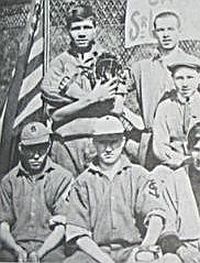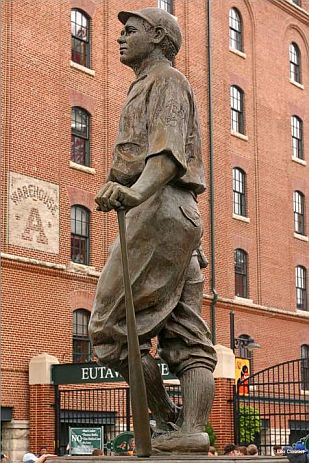
Statue of a young Babe Ruth just outside the gates of Oriole Park at Camden Yards, Baltimore. Statue by Susan Luery; photo by Leo Cloutier, pbase.com. See other statue perspective, below.
The statue of Ruth at today’s Camden Yards Oriole Park portrays him as an older boy, at the edge of young manhood, about the time he was leaving the Baltimore orphanage where he had spent much of his boyhood. The statue is named “Babe’s Dream,” alluding no doubt, to his longing for a big league future, or at least something better than the orphanage.
Ruth was born on February 6th, 1895, a Baltimore saloonkeeper’s son. He became something of a problem child, and at the age 7, his parents placed him in Baltimore’s St. Mary’s Industrial School for Boys for his “incorrigible” behavior. The school was run by Catholic Xaverian brothers, and Ruth spent almost his entire youth there. St. Mary’s was the place where Ruth — with the help and encouragement of Brother Matthias Boutlier — developed into a promising baseball player.
In 1914, Ruth was first signed to play professional baseball by the Baltimore Orioles manager Jack Dunn who had heard about his play at the St. Mary’s orphanage. The Orioles were then a minor league team, and Ruth was signed on as a 19 year-old pitcher. When the other players on the Orioles first saw Ruth, they nicknamed him “Jack’s newest babe” — a moniker that stuck and stayed with Ruth for the rest of his life.
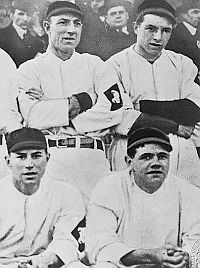 Ruth, bottom right, in his short-lived career with the Baltimore Orioles minor league team for a few months in 1914. |
In The News
In March 1914, Ruth did well in spring training with the Orioles at their camp in North Carolina. He pitched successfully against the major league Philadelphia Athletics on March 25th, and was also hitting some notably long shots as a hitter.
Baltimore’s newspapers began to pick up on the young rookie. At the time, a few early baseball trading cards of Babe Ruth as a Baltimore Oriole also appeared. They were issued in 1914 by the Baltimore News, along with a team photo card with Ruth included.
However, during the 1914 season, the minor league Orioles’ business suffered. The professional Federal League had established a Major League team in Baltimore that year directly across the street from the Orioles. As a result, the Orioles’ attendance plummeted, seating as few as fifty fans in the stands for some games. To avoid bankruptcy, owner Jack Dunn was forced to sell his best players.
Ruth To Boston
About mid-season 1914, in July, Dunn decided to trade Babe Ruth. Dunn packaged Ruth with two other players and asked Connie Mack of the Philadelphia Athletics for $10,000 for all three players. Mack refused the offer. The Cincinnati Reds also passed on the deal. However, on July 9th or 10th, 1914, Dunn sold the trio to the Boston Red Sox for a reported $25,000.
Ruth then appeared in five games for the Red Sox that year, but was sent down to the minors for the remainder of the season — to the Providence Grays of Providence, Rhode Island. At the conclusion of the baseball season that year, Ruth married Helen Woodford, a waitress he had met in Boston. They were married in Ellicott City, Maryland. In the next three years, Ruth played major league baseball for the Boston Red Sox, primarily as a pitcher, but he was also becoming a much-noted power hitter.
According to Lee Montville’s book, The Big Bam, Ruth would play in a pair of games in Baltimore in April 1918 in which the Boston Red Sox played Jack Dunn’s minor league Orioles. Some of Ruth’s old friends from St. Mary’s were likely in the stands, along with a few of the Xaverian Brothers. Ruth was in his early 20s by this time. Ruth went 4-for-4 against the Orioles — all four of his hits were home runs. On the following day, he hit two more home runs in his first two at- bats. In the first game, on April 18, 1918, Ruth went 4-for-4 against the Orioles — all four of his hits were home runs. He also had two walks that game. On the following day, April 19th, he hit two more home runs in hist first two at- bats. No doubt, his old Baltimore pals were pleased. After that game, the Red Sox went on to play the New York Yankees at the Polo Grounds for opening day of the 1918 baseball season. In his first at bat in that game, Ruth hit a lined shot to center field that gave him an inside-the-park home run. The Red Sox beat the Yankees 10-0.
Ruth had become a hitting sensation for the Red Sox, drawing crowds wherever he played. But Boston sold him to the New York Yankees in 1920, where he would go on to have a colossal career, becoming a paramount figure in the game, rejuvenating baseball as a business and setting home runs records.
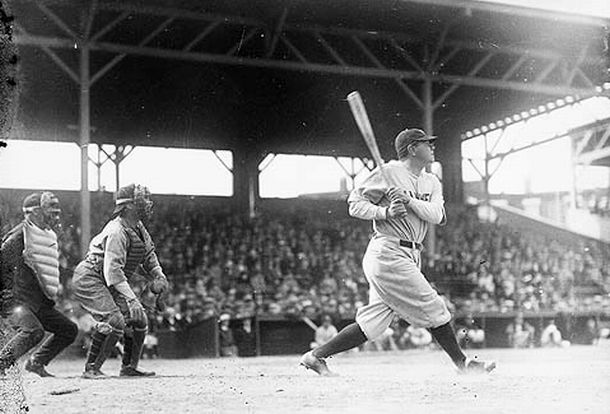
Babe Ruth in action, 1931, at Oriole Park, Baltimore, Maryland. Photo from Robert F. Kniesche / Kniesche Collection / Maryland Historical Society.
There is more about the life and career of Babe Ruth at this website, including, for example, “Babe Ruth Days, 1947-48,” which recounts his glory days and later commemorations in his honor at Yankee Stadium. During his career, Ruth would make appearances from time to time in Baltimore as a player, both at earlier Oriole Parks and other locations, and some photographs of him playing at these parks surface from time to time. There are several photographs of Ruth at Oriole Park in the 1930s, for example, some showing him in action, as the one above.
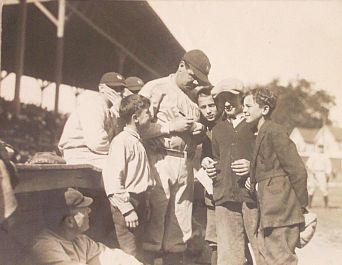
Babe Ruth autographing baseball for kids at Baltimore’s Oriole Park, 1936. Photo by LeRoy Merriken.
Another photograph of Ruth at Oriole Park in the 1930s, displayed at left, shows the Babe in his New York Yankee uniform autographing a baseball in the midst of a crowd of kids. He is standing near the dugout at the old Oriole Park in Baltimore, as several other Yankee players can be seen in the photo as well.
The photo was taken by famous photographer Leroy Merriken. On the back of the black-and-white sepia image, Merriken wrote in blue pen: “Babe Ruth 1936, Oriole Park. Photo by LeRoy Merriken.”
As of February 2009, one web site advertised this photo as an “original unpublished Babe Ruth photograph,” calling it “rare and historic,” offering it for sale at $1,200.
Babe’s Statue
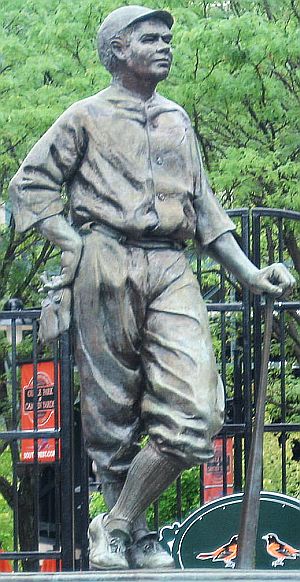
Babe Ruth statue at the Eutaw Street (Gate H) entrance of Oriole Park at Camden Yards, roughly behind center field, where the majority of fans enter the park. Sculpture by Susan Luery.
Susan Luery, a sculptor and Baltimore native, was commissioned to do the Ruth statue. She produced the 9.5-foot bronze likeness of the young Babe after reading books about him and talking to people with both knowledge of Ruth and baseball. She also had a look-alike model come into her studio while she worked on the statue.
“I was intrigued by the concept of Babe Ruth as an American icon — I thought he was amazing,” Luery later said in an interview with The Examiner. “Going into this, I really didn’t know anything about him, but I learned about his disregard for authority, his joy for life, his talent and sense of humor. This [Baltimore] is where Babe Ruth got his start. From a sports aspect, this is important to Baltimore history: He was more than just a ballplayer.”
Luery spent seven months forming the 28-inch model statue before creating the large-scale version. The final statue was nearing completion in late 1994, and ground was broken on its location at Camden Yards on the Babe’s 100th birthday in February 1995. In May, the statue was officially unveiled at an Oriole’s game at which Luery and Ruth’s daughter, Julia Ruth Stevens, threw out the game ball. The 9.5 foot bronze statue portrays a young Ruth leaning on a bat with his left arm, fielder’s glove hanging from his right hand, resting at his hip. Ruth is gazing out into the future. “A man looking at his destiny,” is how Susan Luery put it. “His poise was in the sense of determination that he was a great player,” she said. “He’s facing out — he had everything in front of him.” Indeed he did; Ruth’s career rose pretty much straight into the record books from there.
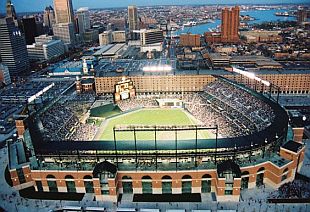
Oriole Park at Camden Yards. Babe Ruth statue is found roughly behind the centerfield scoreboard on the Eutaw Street promenade side, which runs the length of red brick warehouse behind the outfield stands.
Camden Yards
The Ruth statue is located at the Eutaw Street (Gate H) entrance to Oriole Park at Camden Yards. The location is roughly behind centerfield, where the majority of fans enter the ballpark. The location, in fact, is also not far away from where Ruth and his parents lived in the early 1900’s — at 406 Conway Street, in what is now the ballpark’s centerfield. Babe’s father operated Ruth’s Cafe on the ground floor of their residence at the time, and Babe often used the nearby train station.
The Eutaw Street promenade is popular with fans who come to the park, as it runs parallel to the long B & O warehouse and separates it from the ballpark’s seating areas. It’s also in the general area where Baltimore Orioles’ playing legends are honored with large wall numerals, among them, power hitters Frank Robinson (586 career homers) and Eddie Murray (504 career homers). “…I was totally captivated by the magnificent sculp- ture of Babe Ruth…”
– Howard Buchanan Also nearby is the Babe Ruth Museum and Birthplace, the Baltimore row house where Babe Ruth was born, which includes an extensive collection of Babe Ruth memorabilia and exhibits. The Babe Ruth statue, however, remains a favorite photographic venue and meeting location for many who come to the park. And for some, the statue is the high point of their visit.
Howard Buchanan from Cumberland, Maryland, a local official considering Susan Luery in 2005 for a sculpture project in his own town, wrote of his experience coming to Camden Yards to see a baseball game and the Ruth statue:
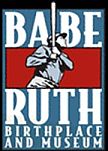
Ruth Museum logo.
“In June 2005, my wife, Rosalyn, son John and daughter Beth treated me to a Father’s Day gift of a weekend in Baltimore. The main item on the schedule was to see a baseball game, Orioles vs. Twins. The game was only the second Major League game that I had ever seen. I was impressed with the condition of the facilities, the ball diamond and the general condition of everything in sight. However, more than by anything else, I was totally captivated by the magnificent sculpture of Babe Ruth. To any boy growing up in the 1930s and ’40s, Babe Ruth was a national hero, and here in this beautiful park, in this magnificent city where he was born and educated, this icon of American athleticism. How appropriate…”
See also at this website: “Baseball Stories,” a topics page with links to additional baseball stories, including two other stories on Ruth – “Babe Ruth Days, 1947 & 1948”( covers special days honoring Ruth at Yankee Stadium and reviews his career); and “Babe Ruth & Tobacco” (Ruth’s endorsements of various cigar, cigarette, and chewing tobacco products, as well as appearances at a tobacco shop in Boston). For additional stories on sport and sports business at this website see “Annals of Sport.” Thanks for visiting – and if you like what you find here, please make a donation to help support the research and writing at this website. Thank you. – Jack Doyle
|
Please Support Thank You |
____________________________
Date Posted: 29 March 2009
Last Update: 12 May 2020
Comments to: jdoyle@pophistorydig.com
Article Citation:
Jack Doyle, “Ruth at Oriole Park, 1930s-2009,”
PopHistoryDig.com, March 29, 2009.
_____________________________
Sources, Links & Additional Information
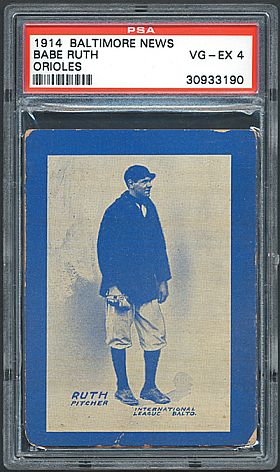
Rare Babe Ruth baseball trading card issued by the Baltimore News in 1914 when Ruth was briefly a minor league player in Baltimore, shown here in its PSA-graded collector’s case. Click for Topps reprint card.
“Sports Briefly,” The Sun (Baltimore, MD), September 1, 1993, p. 2-D.
David J. Williams, “Sculptor’s Model Fine Tunes His Pitch Being the Babe,” The Sun, June 3, 1994, p. 1-D.
“Q&A,” The Sun, Sports, July 7, 1994, p. 7-C.
“Statue Of Babe Has Just One Catch,”Seattle Times.com, June12, 1995.
Charlie Vascellaro, “‘Pigtown’ Site Is House That Babe Ruth Built,” Washington Weekend, Cover Story, Washington Times, February 5, 2004
Leigh Montville, The Big Bam: The Life and Times of Babe Ruth, New York: Doubleday, 2006.
Elizabeth Skalski, “Babe Statue Labor of Love for Baltimore Sculptor,” The Examiner (Baltimore, MD) and Examiner.com, August 14, 2007.
“Original Unpublished Babe Ruth Photograph by Leroy Merriken,” Vintage Baseball Collectibles, as of February 2009.
Jim Rednour, “Ruth Heralded as Hometown Hero With Statue at Camden Yards,” Monday, December 31, 2007.
“1914 Baltimore News Babe Ruth Rookie Card,” June 25, 2007, WatermelonAntiques.com, explores some comparative auction values of the rare Babe Ruth baseball card.
Tyler Kepner, “Visiting the Birthplace of the Babe,” New York Times, Blogs, April 19, 2008.
“Buchanan Says Oriole Park Likeness of Babe Ruth Helped Inspire Courthouse Project,” Cumberland Times-News (Cumberland, MD), December 13, 2008.
“Oriole Park at Camden Yards,” Wikipedia.org.
John Eisenberg, From 33rd Street to Camden Yards: An Oral History of the Baltimore Orioles New York: McGraw-Hill, March 2001.
Jack Doyle, “Babe Ruth Days,1947 & 1948,” PopHistoryDig.com, April 17, 2008.
Thom Loverro, Home of the Game: The Story of Camden Yards, Taylor Trade Publishing, April 1999.
Peter Richmond, Ballpark: Camden Yards and the Building of an American Dream, Fireside, July 2007.
The Babe Ruth Birthplace and Museum, Baltimore, Maryland.
Mike Jensen, “Number 3?”(Babe Ruth), Obit-Mag.com, July 20, 2007.
